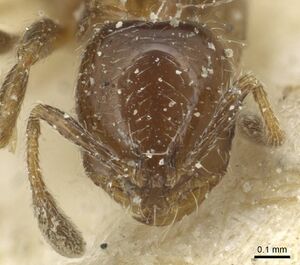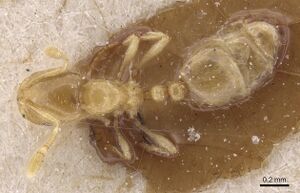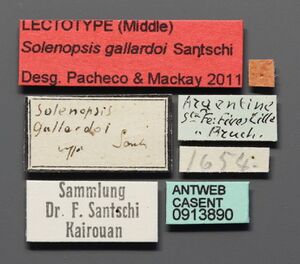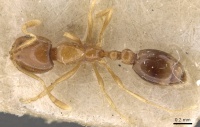Solenopsis parva
| Solenopsis parva | |
|---|---|

| |
| Scientific classification | |
| Kingdom: | Animalia |
| Phylum: | Arthropoda |
| Class: | Insecta |
| Order: | Hymenoptera |
| Family: | Formicidae |
| Subfamily: | Myrmicinae |
| Tribe: | Solenopsidini |
| Genus: | Solenopsis |
| Species complex: | molesta |
| Species: | S. parva |
| Binomial name | |
| Solenopsis parva Mayr, 1868 | |
| Synonyms | |
| |
We found S. parva in creosote bush scrub in the deserts of Argentina and in shrub lands and collected it in pitfall traps in January (summer) in light brown fine sandy soils. (Pacheco and Mackay 2013)
Identification
A New World thief ant that is a member of the molesta species complex. (Key to New World Solenopsis Species Complexes)
Pacheco and Mackay (2013) – Worker - This is a concolorous yellow to brown species with smooth, glossy sculpturing. The head is nearly quadrate with the anterior portion rounded while the posterior is angled at the edges. The lateral clypeal teeth are poorly developed and angu1ate. The eyes are moderately large with approximately 5-8 ommatidia and often kidney-shaped. Both the mesopleuron and metapleuron are horizontally striated. The peduncle is relatively long and extends 0.100 mm from the propodeum. The postpetiole is nearly quadrate viewed dorsally. Queen - The queen is moderately large and concolorous brown in color. What is striking about the queen is the thick scape (maximum diameter 0.096 mm) which is thicker basally and tapers distally towards the minor segments. The propodeum is striated basally.
Solenopsis parva is easily recognized by having reduced angulate clypeal teeth and a moderately large, kidney-shaped eye. The eye separates this species from all other smaller yellow thief ants of the molesta species complex.
Keys including this Species
Distribution
Latitudinal Distribution Pattern
Latitudinal Range: -26.808285° to -40.421°.
| North Temperate |
North Subtropical |
Tropical | South Subtropical |
South Temperate |
- Source: AntMaps
Distribution based on Regional Taxon Lists
Neotropical Region: Argentina (type locality), Brazil (type locality), Uruguay.
Distribution based on AntMaps
Distribution based on AntWeb specimens
Check data from AntWeb
Countries Occupied
| Number of countries occupied by this species based on AntWiki Regional Taxon Lists. In general, fewer countries occupied indicates a narrower range, while more countries indicates a more widespread species. |

|
Estimated Abundance
| Relative abundance based on number of AntMaps records per species (this species within the purple bar). Fewer records (to the left) indicates a less abundant/encountered species while more records (to the right) indicates more abundant/encountered species. |

|
Biology
Castes
Images from AntWeb
   
| |
| Syntype of Solenopsis angulata mendozensis. Worker. Specimen code casent0908811. Photographer Z. Lieberman, uploaded by California Academy of Sciences. | Owned by MHNG, Geneva, Switzerland. |
   
| |
| Syntype of Solenopsis angulata. Worker. Specimen code casent0913875. Photographer Z. Lieberman, uploaded by California Academy of Sciences. | Owned by NHMB, Basel, Switzerland. |
   
| |
| Lectotype of Solenopsis gallardoi. Worker. Specimen code casent0913890. Photographer Will Ericson, uploaded by California Academy of Sciences. | Owned by NHMB, Basel, Switzerland. |
Males have yet to be collected.
Nomenclature
The following information is derived from Barry Bolton's Online Catalogue of the Ants of the World.
- parva. Solenopsis parva Mayr, 1868a: 175 (w.) ARGENTINA (Mendoza).
- Type-material: holotype (?) worker.
- [Note: no indication of number of specimens is given. The original description implies that only a single specimen was present (= holotype); therefore the designation of a lectotype by Pacheco & Mackay, 2013: 251, may be redundant.]
- Type-locality: Argentina: Mendoza, mensibus aestivis (“months of summer”), xii.1865 to iii.1866 (Str.).
- Type-depositories: NHMW.
- Status as species: Mayr, 1870b: 996 (in key); Dalla Torre, 1893: 77; Emery, 1896g: 84 (in key); Bruch, 1914: 223; Emery, 1922e: 200; Santschi, 1931e: 276; Ettershank, 1966: 142; Kempf, 1972a: 238; Bolton, 1995b: 390; Pacheco & Mackay, 2013: 248 (redescription).
- Senior synonym of angulata: Pacheco & Mackay, 2013: 248.
- Senior synonym of dolichops: Pacheco & Mackay, 2013: 248.
- Senior synonym of gallardoi: Pacheco & Mackay, 2013: 248.
- Senior synonym of huasanensis: Pacheco & Mackay, 2013: 248.
- Senior synonym of medozensis: Pacheco & Mackay, 2013: 248.
- Distribution: Argentina, Brazil, Uruguay.
- angulata. Solenopsis angulata Emery, in von Jhering, 1894g: 393 (footnote) (w.q.) BRAZIL (Rio Grande do Sul).
- Type-material: lectotype worker (by designation of Pacheco & Mackay, 2013: 251), 8 paralectotype workers, 2 paralectotype queens.
- Type-locality: lectotype Brazil: Rio Grande do Sul (no further data); paralectotypes with same data.
- Type-depository: MSNG.
- [Misspelled as angustata by Santschi, 1912e: 526.]
- Combination in S. (Diplorhoptrum): Santschi, 1925e: 161;
- combination in S. (Oedaleocerus): Creighton, 1930b: 146.
- Status as species: Emery, 1896g: 85 (in key); Emery, 1906c: 123; Santschi, 1912e: 526; Bruch, 1914: 222; Santschi, 1916e: 377; Emery, 1922e: 198; Borgmeier, 1927c: 102; Creighton, 1930b: 146 (redescription); Eidmann, 1936a: 44; Kusnezov, 1953b: 337; Ettershank, 1966: 139; Kempf, 1972a: 233; Zolessi, et al. 1988: 4; Bolton, 1995b: 386.
- Junior synonym of parva: Pacheco & Mackay, 2013: 248.
- dolichops. Solenopsis angulata var. dolichops Emery, 1906c: 123 (w.q.) ARGENTINA (Chubut).
- Type-material: lectotype worker (by designation of Pacheco & Mackay, 2013: 251), 4 paralectotype workers.
- Type-locality: lectotype Argentina: Chubut, Puerto Camarones (F. Silvestri); paralectotypes with same data.
- Type-depository: MSNG.
- Subspecies of angulata: Bruch, 1914: 222; Santschi, 1916e: 378; Emery, 1922e: 199; Creighton, 1930b: 149; Ettershank, 1966: 140; Kempf, 1972a: 233; Bolton, 1995b: 387.
- Junior synonym of parva: Pacheco & Mackay, 2013: 248.
- gallardoi. Solenopsis (Diplorhoptrum) gallardoi Santschi, 1925e: 160, fig. 5a-b (w.) ARGENTINA (Santa Fe).
- Type-material: lectotype worker (by designation of Pacheco & Mackay, 2013: 251), 2 paralectotype workers.
- [Note: original description cites 7 syntype workers.]
- Type-locality: lectotype Argentina: Santa Fé, Fives Lille (C. Bruch); paralectotypes with same data.
- Type-depository: NHMB.
- Status as species: Ettershank, 1966: 141; Kempf, 1972a: 235; Bolton, 1995b: 387.
- Junior synonym of parva: Pacheco & Mackay, 2013: 248.
- huasanensis. Solenopsis angulata r. huasanensis Forel, 1912g: 8 (w.) ARGENTINA (Catamarca).
- Type-material: lectotype worker (by designation of Pacheco & Mackay, 2013: 250), 4 paralectotype workers.
- Type-locality: lectotype Argentina: Huasan (C. Bruch); paralectotypes with same data.
- Type-depository: MHNG.
- Subspecies of angulata: Forel, 1914d: 278; Bruch, 1914: 222; Bruch, 1916: 318; Emery, 1922e: 199; Creighton, 1930b: 150; Santschi, 1933e: 115; Ettershank, 1966: 141; Kempf, 1972a: 233; Bolton, 1995b: 388.
- Junior synonym of parva: Pacheco & Mackay, 2013: 248.
- mendozensis. Solenopsis angulata r. mendozensis Forel, 1914d: 277.
- Type-material: holotype worker.
- Type-locality: Argentina: Mendoza (C. Bruch).
- Type-depository: MHNG.
- [First available use of Solenopsis angulata r. carettei var. mendozensis Forel, 1913l: 223 (w.) ARGENTINA (Mendoza); unavailable (infrasubspecific) name.]
- As unavailable (infrasubspecific) name: Bruch, 1914: 222; Bruch, 1915: 531; Santschi, 1916e: 378; Gallardo, 1919b: 245; Ettershank, 1966: 142.
- Subspecies of angulata: Forel, 1914d: 277; Bruch, 1916: 320; Emery, 1922e: 199; Creighton, 1930b: 150; Kempf, 1972a: 233; Bolton, 1995b: 389.
- Junior synonym of parva: Pacheco & Mackay, 2013: 248.
Unless otherwise noted the text for the remainder of this section is reported from the publication that includes the original description.
Description
Worker
Pacheco and Mackay (2013) - Measurements (n=7). TL 1.56-1.62 (1.58); HL 0.420-0.456 (0.443); HW 0.378-0.408 (0.389); EL 0.060-0.078 (0.070); ED 0.048-0.060 (0.053); SL 0.270-0.360 (0.314); FSL 0.120-0.138 (0.126); CI 82.9-93.2 (87.9); SI 61.6-78.9 (70.9); PL 0.066-0.078 (0.072); PW 0.084-0.096 (0.090); PI 73.3-86.7 (79.9); PPL 0.120; PPW 0.126-0.144 (0.134); PPI 83.3-95.2 (89.7); WL 0.300-0.360 (0.343); PSL 0.024; PSW 0.024.
Small; concolorous yellow to brown; head quadrate, longer than wide, finely punctate; lateral clypeal teeth poorly developed, angulate, extralateral teeth absent; clypeal carinae well defined; scape long, reaches 3/4 length of head; minor funicular segments moderately long; eyes black, large, kidney shaped, approximately 5-8 ommatidia; pronotum smooth and shiny; metapleuron horizontally striated, especially basally; notopropodeal suture well depressed, groove breaks sculpture of mesosoma; posterior edge of propodeum slightly angulate; propodeal spiracle small, round; metapleuron horizontally striated; peduncle relatively long; petiolar peduncle lacking tooth or flange ventrally, wider than postpetiole viewed laterally; postpetiole nearly quadrate viewed dorsally, larger than petiole.
Sparsely to moderately pilose, pilosity yellow to light brown; erect and suberect hairs scattered on all body surfaces.
Queen
Pacheco and Mackay (2013) - Measurements (n=2). TL 3.96-4.80 (4.38); HL 0.690-0.720 (0.705); HW 0.660-0.720 (0.690); EL 0.204-0.210 (0.207); ED 0.132-0.156 (0.144); MOL 0.054; MOD 0.054; SL 0.480-0.510 (0.495); FSL 0.270-0.282 (0.276); CI 95.7-100 (97.8); SI 69.6-70.8 (70.2); PSL 0.060; PSW 0.060; PL 0.120; PW 0.270-0.276 (0.273); PI 43.5-44.4 (43.9); PPL 0.240; PPW 0.390-0.402 (0.396); PPI 59.7-61.5 (60.6); WL 0.900.
Moderately large; concolorous brown; head quadrate, semi-coarsely punctate; lateral clypeal teeth angulate, extralateral teeth present as bumps; clypeal carinae well defined; frontal lobes weakly striated; scape long, reaching 3/4 length of head, thickened basally, tapered towards minor segments; minor funicular segments 3-8 long; eyes large, oval, extend 0.054 mm past sides of border of head; medial ocellus small, without pigment; pronotum semi-coarsely punctate, smooth and shiny between punctures; posterior edge of propodeum slightly angulate; propodeal spiracle large, round; metapleuron striated basally below spiracle; petiolar peduncle with minute, thin flange ventrally; postpetiole lacking tooth or flange ventrally.
Abundantly hairy, pilosity yellow to light brown; erect and suberect hairs of various lengths (0.090-0.240 mm) covering all body surfaces; scape with numerous suberect hairs (0.150 mm), especially basally; most hairs on mesosoma, petiole, postpetiole and gaster curve posteriorly.
References
- Mayr, G. 1868b. Formicidae novae Americanae collectae a Prof. P. de Strobel. Annu. Soc. Nat. Mat. Modena 3: 161-178 (page 175, worker described)
- Pacheco, J.A. & Mackay, W.P. 2013. The systematics and biology of the New World thief ants of the genus Solenopsis (Hymenoptera: Formicidae). Edwin Mellen Press, Lewiston, New York. 501 pp.
References based on Global Ant Biodiversity Informatics
- Bruch C. 1914. Catálogo sistemático de los formícidos argentinos. Revista del Museo de La Plata 19: 211-234.
- Bruch C. 1916. Contribución al estudio de las hormigas de la provincia de San Luis. Revista del Museo de La Plata 23: 291-357.
- Creighton W. S. 1930. The New World species of the genus Solenopsis (Hymenop. Formicidae). Proceedings of the American Academy of Arts and Sciences 66: 39-151.
- Cuezzo, F. 1998. Formicidae. Chapter 42 in Morrone J.J., and S. Coscaron (dirs) Biodiversidad de artropodos argentinos: una perspectiva biotaxonomica Ediciones Sur, La Plata. Pages 452-462.
- Ettershank G. 1966. A generic revision of the world Myrmicinae related to Solenopsis and Pheidologeton (Hymenoptera: Formicidae). Aust. J. Zool. 14: 73-171.
- Fernández, F. and S. Sendoya. 2004. Lista de las hormigas neotropicales. Biota Colombiana Volume 5, Number 1.
- Forel A. 1912. Formicides néotropiques. Part IV. 3me sous-famille Myrmicinae Lep. (suite). Mémoires de la Société Entomologique de Belgique. 20: 1-32.
- Forel A. 1913. Fourmis d'Argentine, du Brésil, du Guatémala & de Cuba reçues de M. M. Bruch, Prof. v. Ihering, Mlle Baez, M. Peper et M. Rovereto. Bulletin de la Société Vaudoise des Sciences Naturelles. 49: 203-250.
- Kempf, W.W. 1972. Catalago abreviado das formigas da regiao Neotropical (Hym. Formicidae) Studia Entomologica 15(1-4).
- Kusnezov N. 1956. Claves para la identificación de las hormigas de la fauna argentina. Idia 104-105: 1-56.
- Kusnezov N. 1957. Die Solenopsidinen-Gattungen von Südamerika (Hymenoptera, Formicidae). Zoologischer Anzeiger 158: 266-280.
- Kusnezov N. 1978. Hormigas argentinas: clave para su identificación. Miscelánea. Instituto Miguel Lillo 61:1-147 + 28 pl.
- Pacheco J. A., and W. P. Mackay. 2013. The systematics and biology of the New World thief ants of the genus Solenopsis (Hymenoptera: Formicidae). Lewiston, New York: Edwin Mellen Press, 501 pp.
- Santschi F. 1916. Descriptions de fourmis nouvelles d'Afrique et d'Amérique. Annales de la Société Entomologique de France 84: 497-513.
- Santschi F. 1916. Formicides sudaméricains nouveaux ou peu connus. Physis (Buenos Aires). 2: 365-399.
- Santschi F. 1925. Fourmis des provinces argentines de Santa Fe, Catamarca, Santa Cruz, Córdoba et Los Andes. Comunicaciones del Museo Nacional de Historia Natural "Bernardino Rivadavia" 2: 149-168.
- Santschi F. 1931. Contribution à l'étude des fourmis de l'Argentine. Anales de la Sociedad Cientifica Argentina. 112: 273-282.
- Santschi F. 1933. Fourmis de la République Argentine en particulier du territoire de Misiones. Anales de la Sociedad Cientifica Argentina. 116: 105-124.
- Vittar, F. 2008. Hormigas (Hymenoptera: Formicidae) de la Mesopotamia Argentina. INSUGEO Miscelania 17(2):447-466
- Vittar, F., and F. Cuezzo. "Hormigas (Hymenoptera: Formicidae) de la provincia de Santa Fe, Argentina." Revista de la Sociedad Entomológica Argentina (versión On-line ISSN 1851-7471) 67, no. 1-2 (2008).
- Zolessi L. C. de; Y. P. de Abenante, and M. E. Philippi. 1989. Catálogo sistemático de las especies de Formícidos del Uruguay (Hymenoptera: Formicidae). Montevideo: ORCYT Unesco, 40 + ix pp.
- de Zolessi, L.C., Y.P. de Abenante and M.E. Philippi. 1987. Lista sistemática de las especies de formícidos del Uruguay. Comunicaciones Zoologicas del Museo de Historia Natural de Montevideo 11(165):1-9

